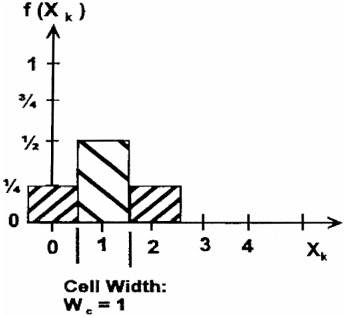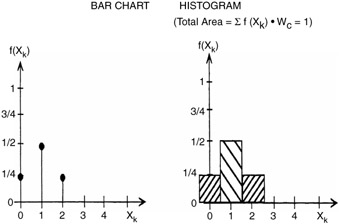DISCRETE PROBABILITY DISTRIBUTION
Discrete probability density function: probability assigned to AREA of discrete random variable cells .
Probability ( Cell area) = Height (X k ) · Width (W c )
Discrete probability is the frequency of the grouped values x = X k for the data corresponding to the individual event S i in sample space. This may be shown in a pictorial form in Figure 16.1.

Figure 16.1: Discrete probability density function.
However, when data are grouped as consecutive integer values the cell width is unity; W c = 1.
-
Probability of group data with cell width W c :
P(x = X k ) = f (X k ) · W c ; k = 1, 2, 3, ..., K
where f(X k ) is the probability density for the RV cell X k , which has a sample frequency f k for a total sample size of n:
f(X k ) = f k /n
-
Discrete probability density function properties:
-
Positive 0 < P (X k ) = f(X k ) · W c
-
Unit area (area is sum under curve unity)

-
RANDOM EXPERIMENT
Two tosses of a coin.
Random variable of sample event X i is defined as the number of heads to appear in two tosses.
{S i } = {TT, TH, HT, HH} ’ {X i } = {0, 1, 1, 2}
-
SAMPLE SPACE: TT TH HT HH
-
Probability (sample space): 1/4 1/4 1/4 1/4
-
Random Variable X i : 0 1 1 2 ’ ascending (Number of Heads)
-
Grouping into four cells each of width, W k = 1;
-
Discrete probability density function f(X k ):
f(0) = 1/4; f(1) = 1/4 + 1/4 = 1/2; f(2) = 1/4
The above may be represented in graphic displays as in Figure 16.2.

Figure 16.2: A bar chart and a histogram of two tosses of a coin.
EAN: 2147483647
Pages: 252